Giant Gippsland Earthworm
Did The Earth Move For You Too?
If you are out wandering along the creeks and slopes of South and West Gippsland, don’t be startled if you hear a loud, gurgling sound like this beneath your feet: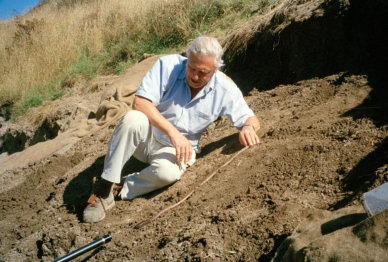

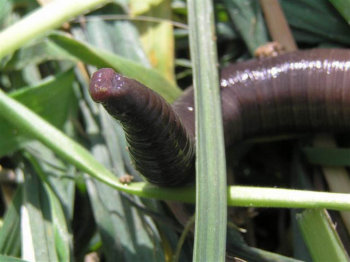
Dig
a
little
deeper
and
unearth
some
of
the
secrets
of
the
Giant
Gippsland
Earthworm
by
exploring
this
website.
Find
out
how
you
can
identify
and
manage
GGE
habitat
on
your
farm,
and
be
part
of
this
exciting new project.
Site content written by Dr. Beverley Van Praagh (BSc. PhD.) who has been studying the Giant Gippsland Earthworm for the past 30 years.
Project content written in collaboration with various project partners.
Website by VP-IT
All photographs © Dr. Beverley Van Praagh, Invert-Eco unless otherwise stated. No image may be saved, copied, reproduced or distributed without prior permission from the copyright owner.
| Giant Gippsland Earthworm | Giant Earthworm Project | Giant Worm Resources | Giant Gippsland Earthworm Images & Photos |
Farmers As Custodians
It’s not just national parks and nature reserves that are important for protecting our threatened plants and animals; farmland also plays a role in biodiversity conservation. This is imperative for threatened species such as the Giant Gippsland Earthworm, where the farmers of South and West Gippsland are the custodians of the majority of its habitat. Working together and managing farms in ways that protect GGE habitat will help ensure that GGEs continue to survive and thrive. Victorian Government’s Biodiversity Response Planning Project (BRP) In 2018, a partnership project between DELWP Gippsland, Federation University, Gippsland Water, Latrobe Catchment Landcare Network, and South Gippsland Landcare Network was awarded a Grant under the State Government’s Biodiversity Response Planning Project (BRP) to promote the conservation of four species of threatened invertebrates found in the western end of the Strzelecki Ranges. It builds on an earlier Federal Government project “Building Capability To Manage GGE Habitat On Farms”. The project has two aims: • investigate the potential of eDNA to assist in identifying different species of burrowing crayfish in the field; and • work with landowners to ensure that habitats of Giant Gippsland Earthworm and burrowing crayfish are protected on rural properties. This involves undertaking appropriate revegetation and providing support for on-ground works such as deer control and fencing where required.
Click any image to enlarge
Email: info@giantearthworm.org.au
Please click play below to listen

Giant Gippsland Earthworms are a
protected species in Victoria.
They are very fragile animals and
digging up these worms to view them
or handling them incorrectly is likely to
result in their death.
We do not encourage any digging up or
handling of these worms unnecessarily.
The best way to conserve these worms
is to protect their habitat and leave
them in their underground homes.



This is the sound of a giant worm squelching its way in the darkness along its wet burrow.
Although Australia has over 1000 species of native earthworms, Gippsland is home to
possibly the largest and undoubtedly the most famous of all earthworms - the Giant
Gippsland Earthworm.
LATEST NEWS
• Enhanced Knowledge and Protection of the Giant Gippsland Earthworm (GGE) Interactive Resource • Updated Revegetation Guidelines & Giant Gippsland Earthworm (GGE) Habitat Landform • Threatened Invertebrates of the Western Strzeleckis - Protecting Giant Gippsland Earthworms on Farms - Vimeo • Looking After Your Neighbours (worms & crayfish) Case Study (.pdf) • Biodiversity Response Planning Field Day Interview - Vimeo • Giant Gippsland Earthworm Video - flooded out of it’s burrow - YouTube
This gigantic earthworm has had an audience with a King, featured in festivals, (Moomba,
Karmai and a variety show) and stared alongside Sir David Attenborough in the BBC’s 2005 tv
series Life in the Undergrowth. Despite all this attention, many of its habits and behaviours
remain secret, hidden beneath the clay pastures of Gippsland.


Giant Gippsland Earthworm
Did The Earth Move For You Too?
If you are out wandering along the creeks and slopes of South and West Gippsland, don’t be startled if you hear a loud, gurgling sound like this beneath your feet: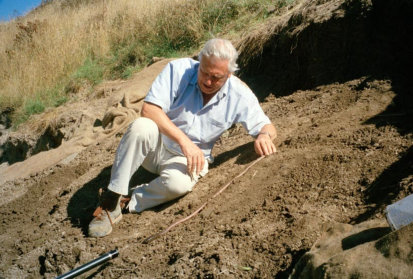
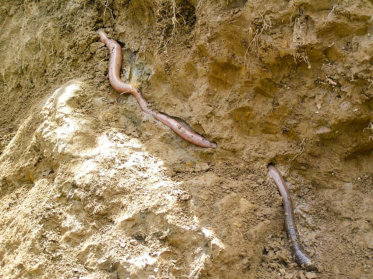
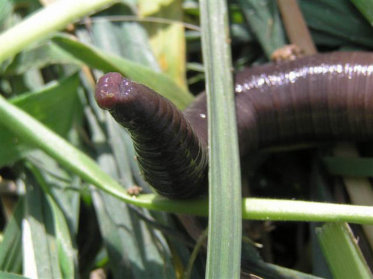
Dig
a
little
deeper
and
unearth
some
of
the
secrets
of
the
Giant
Gippsland
Earthworm
by
exploring
this
website.
Find
out
how
you
can
identify
and
manage
GGE
habitat
on
your
farm,
and
be part of this exciting new project.
Site content written by Dr. Beverley Van Praagh (BSc. PhD.)
who has been studying the Giant Gippsland Earthworm for
the past 30 years.
Project content written in collaboration with various
project partners.
Farmers As Custodians
It’s not just national parks and nature reserves that are important for protecting our threatened plants and animals; farmland also plays a role in biodiversity conservation. This is imperative for threatened species such as the Giant Gippsland Earthworm, where the farmers of South and West Gippsland are the custodians of the majority of its habitat. Working together and managing farms in ways that protect GGE habitat will help ensure that GGEs continue to survive and thrive. Victorian Government’s Biodiversity Response Planning Project (BRP) In 2018, a partnership project between DELWP Gippsland, Federation University, Gippsland Water, Latrobe Catchment Landcare Network, and South Gippsland Landcare Network was awarded a Grant under the State Government’s Biodiversity Response Planning Project (BRP) to promote the conservation of four species of threatened invertebrates found in the western end of the Strzelecki Ranges. It builds on an earlier Federal Government project “Building Capability To Manage GGE Habitat On Farms”. The project has two aims: • investigate the potential of eDNA to assist in identifying different species of burrowing crayfish in the field; and • work with landowners to ensure that habitats of Giant Gippsland Earthworm and burrowing crayfish are protected on rural properties. This involves undertaking appropriate revegetation and providing support for on- ground works such as deer control and fencing where required.
Click any image to enlarge
All photographs © Dr. Beverley Van Praagh, Invert-Eco unless otherwise stated.
No image may be saved, copied, reproduced or distributed without prior
permission from the copyright owner.
Email: info@giantearthworm.org.au
Website by VP-IT
Please click play below to listen
This is the sound of a giant worm squelching its way in the
darkness along its wet burrow. Although Australia has over
1000 species of native earthworms, Gippsland is home to
possibly the largest and undoubtedly the most famous of all
earthworms - the Giant Gippsland Earthworm.


Giant Gippsland Earthworms are a
protected species in Victoria.
They are very fragile animals and
digging up these worms to view them
or handling them incorrectly is likely to
result in their death.
We do not encourage any digging up or
handling of these worms unnecessarily.
The best way to conserve these worms
is to protect their habitat and leave
them in their underground homes.



LATEST NEWS
• Enhanced Knowledge and Protection of the Giant Gippsland Earthworm (GGE) Interactive Resource • Updated Revegetation Guidelines & Giant Gippsland Earthworm (GGE) Habitat Landform • Threatened Invertebrates of the Western Strzeleckis - Protecting Giant Gippsland Earthworms on Farms - Vimeo • Looking After Your Neighbours (worms & crayfish) Case Study (.pdf) • Biodiversity Response Planning Field Day Interview - Vimeo • Giant Gippsland Earthworm Video - flooded out of it’s burrow - YouTube
This gigantic earthworm has had an audience with a King,
featured in festivals, (Moomba, Karmai and a variety show) and
stared alongside Sir David Attenborough in the BBC’s 2005 tv
series Life in the Undergrowth. Despite all this attention,
many of its habits and behaviours remain secret, hidden
beneath the clay pastures of Gippsland.






















